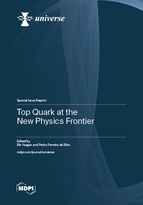Top Quark at the New Physics Frontier
A special issue of Universe (ISSN 2218-1997). This special issue belongs to the section "High Energy Nuclear and Particle Physics".
Deadline for manuscript submissions: closed (31 May 2023) | Viewed by 17659
Special Issue Editors
Interests: high-energy physics; top quark; standard model; Higgs boson; physics generators and modelling; calorimetry; high energy astrophysics; computational physics
Special Issue Information
Dear Colleagues,
The hunt for top quarks began back in the 1970s after the proposal of the six-quark model by Kobayashi and Maskawa, and it was discovered in 1995 at the Fermilab Tevatron. It has been experimentally established by five different experiments in different production modes and a variety of collision energies.
At the CERN Large Hadron Collider (LHC), top quark–antiquark pairs are routinely produced at a rate of about 6 per minute, enabling experiments to make detailed measurements of the properties of top quarks. The analysis of the data collected by the first two LHC runs has revealed, so far, good agreement with the standard model (SM) predictions. The attained percentage-level precision in several measurements has been possible thanks to the excellent performance of the Tevatron and LHC accelerators and experiments. Accurate and precise theory calculations and Monte Carlo simulations also play a crucial role in the results obtained so far. In some cases, these accurate measurements are pushing the boundaries of physics and technology.
The top quark is the most massive elementary particle identified to date: not only does it have a privileged Yukawa coupling to the Higgs boson, but also its mass is significantly higher than that of the Higgs boson. Owing to its large mass, the top quark decays before hadronization, making the study of “bare” quark properties possible in experimental settings. Therefore, top quark physics simultaneously pushes the frontier of quantum chromo-dynamics, electroweak, and flavor physics. Of particular relevance is the fact that, taken together, the top quark and the Higgs boson modify the tree level SM processes through radiative corrections. Such corrections are potentially sensitive to new physics contributions from energy scales larger than that which the current accelerators can achieve.
The aim of this Special Issue of Universe is to provide a comprehensive review of the current status and prospects of top quark physics at the LHC and possible future colliders. We especially welcome articles that emphasize where the present understanding is incomplete, and suggest new directions for research in this area.
Best regards,
Dr. Efe YazganDr. Pedro Ferreira da Silva
Guest Editors
Manuscript Submission Information
Manuscripts should be submitted online at www.mdpi.com by registering and logging in to this website. Once you are registered, click here to go to the submission form. Manuscripts can be submitted until the deadline. All submissions that pass pre-check are peer-reviewed. Accepted papers will be published continuously in the journal (as soon as accepted) and will be listed together on the special issue website. Research articles, review articles as well as short communications are invited. For planned papers, a title and short abstract (about 100 words) can be sent to the Editorial Office for announcement on this website.
Submitted manuscripts should not have been published previously, nor be under consideration for publication elsewhere (except conference proceedings papers). All manuscripts are thoroughly refereed through a single-blind peer-review process. A guide for authors and other relevant information for submission of manuscripts is available on the Instructions for Authors page. Universe is an international peer-reviewed open access monthly journal published by MDPI.
Please visit the Instructions for Authors page before submitting a manuscript. Submitted papers should be well formatted and use good English. Authors may use MDPI's English editing service prior to publication or during author revisions.
Keywords
- Particles and Fields (12.00.00)
- Top quark (14.65.Ha)
- Quantum Chromodynamics (12.38.−t)
- Electroweak interactions (12.15.−y)
- Quark and lepton masses and mixing (12.15.Ff)
- Models beyond the standard model (12.60.−i)
- Experimental methods and instrumentation for elementary-particle and nuclear physics (29.00.00)
- Data analysis (07.05.Kf)







